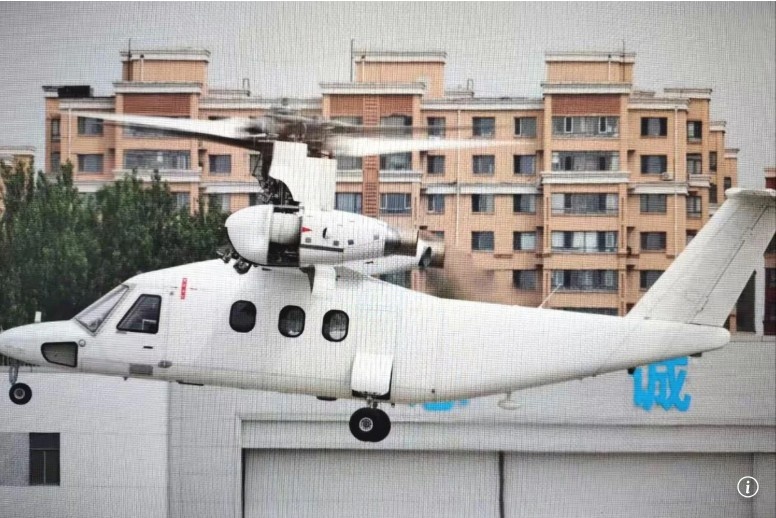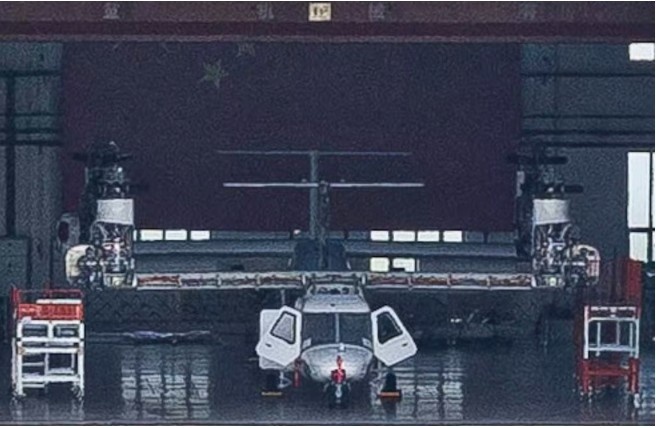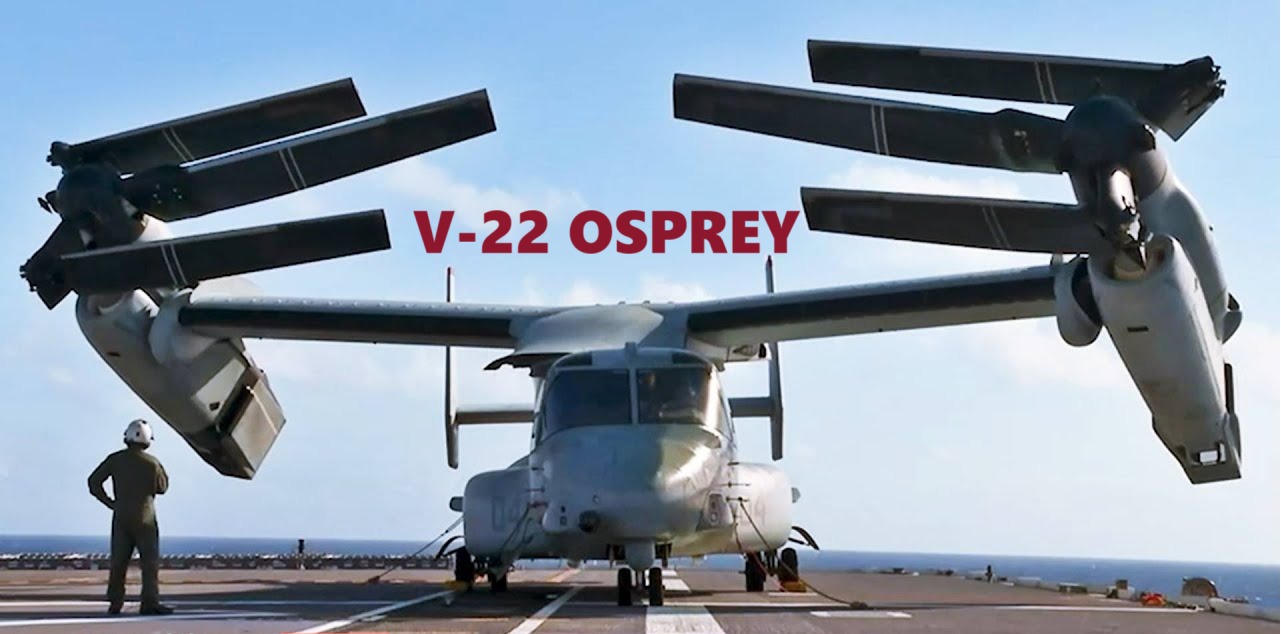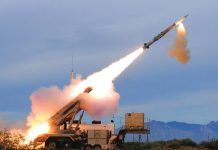China has made tremendous progress in military aviation during the last two decades. It became only the second country, after the US, to have two operational fifth-generation stealth aircraft, and is also testing two distinct sixth-generation manned fighter aircraft.
However, there was one aviation field where Beijing still had a capability gap vis-à-vis the US – in the technologically challenging but highly useful area of tilt-rotor aircraft. That might not be the case for too long.
New images have appeared on Chinese social media platforms showing a Chinese version of the US military’s Osprey tiltrotor aircraft, in what seems to be its maiden flight.
If the flight-testing is successful, then this could become China’s first tilt-rotor aircraft. Notably, China is already testing a large tiltrotor drone —the Zhang Ying R6000 (also known as UR6000). The drone appeared in prototype form late last year.
R6000, a 6-metric-ton tiltrotor drone produced by Chinese OEM United Aircraft Wuhu Aviation Industrial Park in China’s eastern Anhui province, was initially designed for civilian missions like cargo and passenger transport. However, at least one rendering on the manufacturer’s website now shows the R6000 in PLA markings.

According to reports, the UAV will have a cruise speed of 550km/h (342mph) and a range of 4,000km (2,485 miles), with a capability of carrying 12 people.
Similarly, while the tilt-rotor aircraft is being tested for civil aviation, the technology clearly has strong military applications as well, especially in the Pacific Ocean theatre, where Beijing needs aircraft that can land and take off vertically from small airfields and even amphibious assault ships.
The PLA also has a significant requirement to deliver heavy cargoes to remote locations in the Pacific Ocean.
China’s New Tilt-Rotor Aircraft
The picture circulating on Chinese social media platforms shows a white prototype tilt-rotor aircraft hovering in front of a residential building with its rotors positioned vertically, indicating that it was in helicopter mode.
The cockpit design of the tilt-rotor aircraft suggests that it is a crewed platform.
Though it was not immediately clear when the picture was taken, comments on social media claim that the location was near a facility belonging to Harbin Aircraft Industry Group, a subsidiary of state-owned Aviation Industry Corporation of China (AVIC).

Another picture showed two incomplete tilt-rotor aircraft parked inside a hangar, with some mechanical structures exposed, suggesting that soon there will be more than one prototype.
Notably, the AVIC has exhibited a model of the aircraft during the Zhuhai air show in 2023, where it was labelled for civilian uses such as transport, logistics, disaster relief, and emergency rescue. This is the first time the aircraft has been pictured in flight mode.
What Is Tiltrotor Technology?
A tiltrotor aircraft combines helicopter and airplane technology. It’s an aircraft that can take off and land vertically like a helicopter but also fly forward like a plane.
It merges a helicopter’s vertical take-off and landing (VTOL) capability with the significantly higher speed, range, and altitude of a fixed-wing turboprop aeroplane.
During take-off and landing, its rotors point straight up, allowing it to hover like a helicopter. Once airborne, the rotors tilt horizontally, enabling it to transition into forward flight.
This means it doesn’t need a runway to take off or land, yet it can still cover long distances quickly and efficiently. It’s often called a ‘hybrid VTOL aircraft’ because it switches between vertical and forward flight by adjusting the position of its rotors.
However, this versatility in operations also brings with it technological complexities and extremely high procurement and maintenance costs, as well as safety concerns, as exemplified by the troubled history of Bell-Boeing V-22 Osprey.
The Troubled History Of Bell-Boeing V-22 Osprey
The US has extensively used the V-22 Osprey for transport and medical operations in the Middle East and Afghanistan.
The aircraft’s VTOL capability offers unique tactical advantages; however, at the same time, it is challenging to fly, expensive to maintain, and has a controversial safety record, marked by multiple accidents followed by forced groundings.
The Osprey fleet had been grounded between December 2023 and March 2024 following the tragic crash on November 29, 2023, when a US Special Operations Command Osprey went down off Yakushima, an island south of Kyushu, resulting in the loss of all eight crew members.
The official report indicated that the crash was caused by a severe mechanical failure, which was further aggravated by the crew’s “lack of urgency” in responding to the situation.
This crash became the deadliest Air Force mishap since 2018 and marked the fourth fatal Osprey accident in just two years, contributing to a large death toll of 20 US service members in Osprey-related incidents since March 2022.
The Bell-Boeing Osprey has a troubled history, with a record of numerous fatal accidents since its first flight in 1989.
Despite its critical role in various military operations, the Osprey has been beset by a range of safety issues, earning it the unfortunate nickname “the widow-maker.”
This reputation has only been amplified by recurring technical problems, particularly with the gearbox system, which have led to public concerns in Japan and the US regarding the aircraft’s dependability.
One persistent issue with the Osprey has been “hard clutch engagement,” a malfunction where the clutch disconnects from the rotor system and unexpectedly re-engages, resulting in a dangerous drop in altitude and potential loss of lift.
The US military currently operates hundreds of V-22s, with the Marine Corps owning nearly 350 of these aircraft. The Air Force and Navy each manage smaller fleets of around 50 and 30 units, respectively. The Japan Self-Defence Forces have inducted 14 MV-22s.
Last year, a Pentagon test report indicated that the tilt-rotor aircraft CMV-22B Osprey were “Not Operationally Suitable.”

V-22 Osprey Vs Chinese Tiltrotor Aircraft
Unlike the V-22 Osprey, in which both the engine nacelles and proprotors tilt together, the Chinese prototype appears to have only the proprotors rotating while the engines remain fixed. This design could reduce mechanical complexity and improve system reliability, the SCMP reported.
The prototype also appears to be much smaller than the Osprey, which has a maximum take-off weight of 27 tonnes.
Furthermore, the Osprey could carry 24 combat-equipped troops in its standard configuration. In a high-density setup, it can accommodate up to 32 soldiers. Given the Chinese tilt-rotor aircraft’s smaller size, it is expected to carry only 12-16 troops.
Still, the tilt-rotor aircraft could add a significant capability boost to China. However, the beginning of flight testing does not mean that the aircraft is close to operational certification.
A case in point is AgustaWestland AW609. The tilt-rotor aircraft has been in development for the last 27 years, since 1998, and yet, it passed the first stage of certification by the US Federal Aviation Administration (FAA), the so-called Type Inspection Authorization, only in March this year.
However, China has, in the past, surprised the world with the speed of integrating new technologies. It will be interesting to see how long it takes Beijing to certify the tilt-rotor aircraft.




